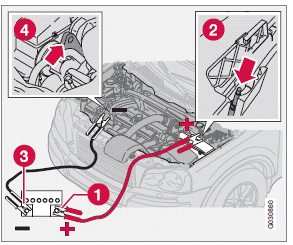Jump starting


Follow these instructions to jump start your vehicle's dead battery or to jump start another vehicle's dead battery using your vehicle.
Although your vehicle's battery is located under the floor of the cargo area, jumper cables should be connected in the engine compartment, to the points shown in the illustrations.
If the 12-volt auxiliary battery to be used is in another vehicle, check that the vehicles are not touching to prevent premature completion of a circuit. Be sure to follow jump starting instructions provided for the other vehicle.
To jump start your vehicle:
1. Switch off the ignition.
2. First connect the auxiliary battery positive
(+) terminal (1) to the positive (+) terminal in
your vehicle's engine compartment (2),
located under a small black plastic cover
attached to the fuse box cover, marked
with a "+" sign. Remove the cover on the
main fuse box if necessary to access this
terminal. Then connect the auxiliary battery's
negative (Ц) terminal (3) to the ground
point in your vehicle's engine compartment
(4).
3. Start the engine in the assisting vehicle,
then start the engine in the vehicle with
dead battery.
4. After the engine has started, first remove
the negative (Ц) terminal jumper cable.
Then remove the positive (+) terminal jumper cable.
WARNING
PROPOSITION 65 WARNING!
Battery posts, terminals, and related accessories
contain lead and lead compounds,
chemicals known to the state of California
to cause cancer and reproductive harm.
Wash hands after handling.
WARNING
Х Do not connect the jumper cable to any
part of the fuel system or to any moving
parts. Avoid touching hot manifolds.
Х Never expose the battery to open flame
or electric spark.
Х Do not smoke near the battery.
Х Batteries generate hydrogen gas, which
is flammable and explosive.
Х Battery fluid contains sulfuric acid. Do
not allow battery fluid to contact eyes,
skin, fabrics or painted surfaces. If contact
occurs, flush the affected area
immediately with water. Obtain medical
help immediately if eyes are affected.
Х Failure to follow the instructions for
jump starting can lead to personal
injury.
See also:
Limitations
Even if a fairly small section of the screen image
appears to be obstructed, this may mean that
a relatively large area behind the vehicle is hidden
and objects there may not be detected
until ...
Engine specifications
A This engine may not be available on all markets ...
Driving Dynamics: Chassis
The compact Volvo V50 Sportswagon delivers an engaging, dynamic driving
experience with a high level of active safety. To achieve this, it makes use of
a sophisticated suspension system, a high le ...
